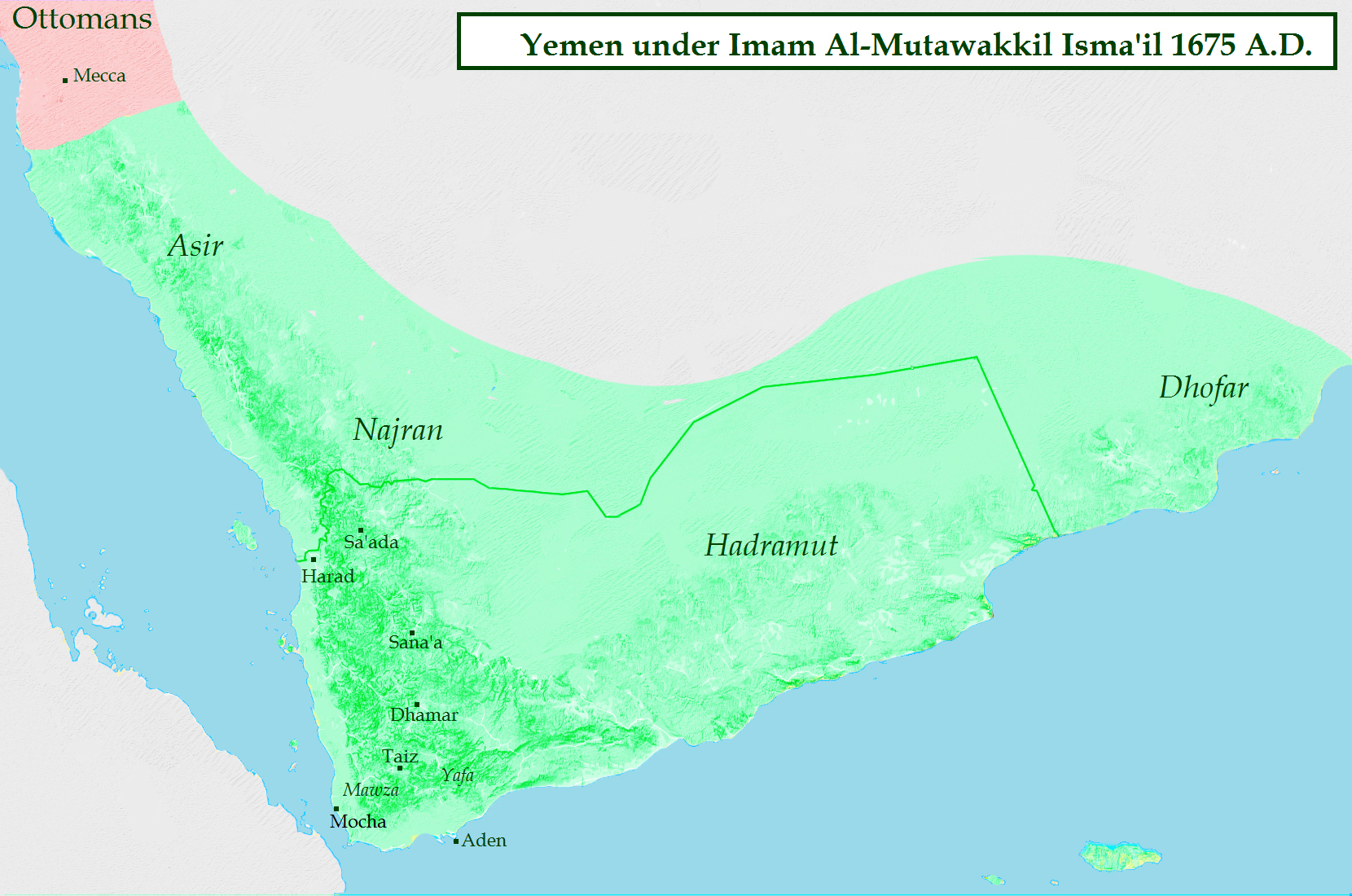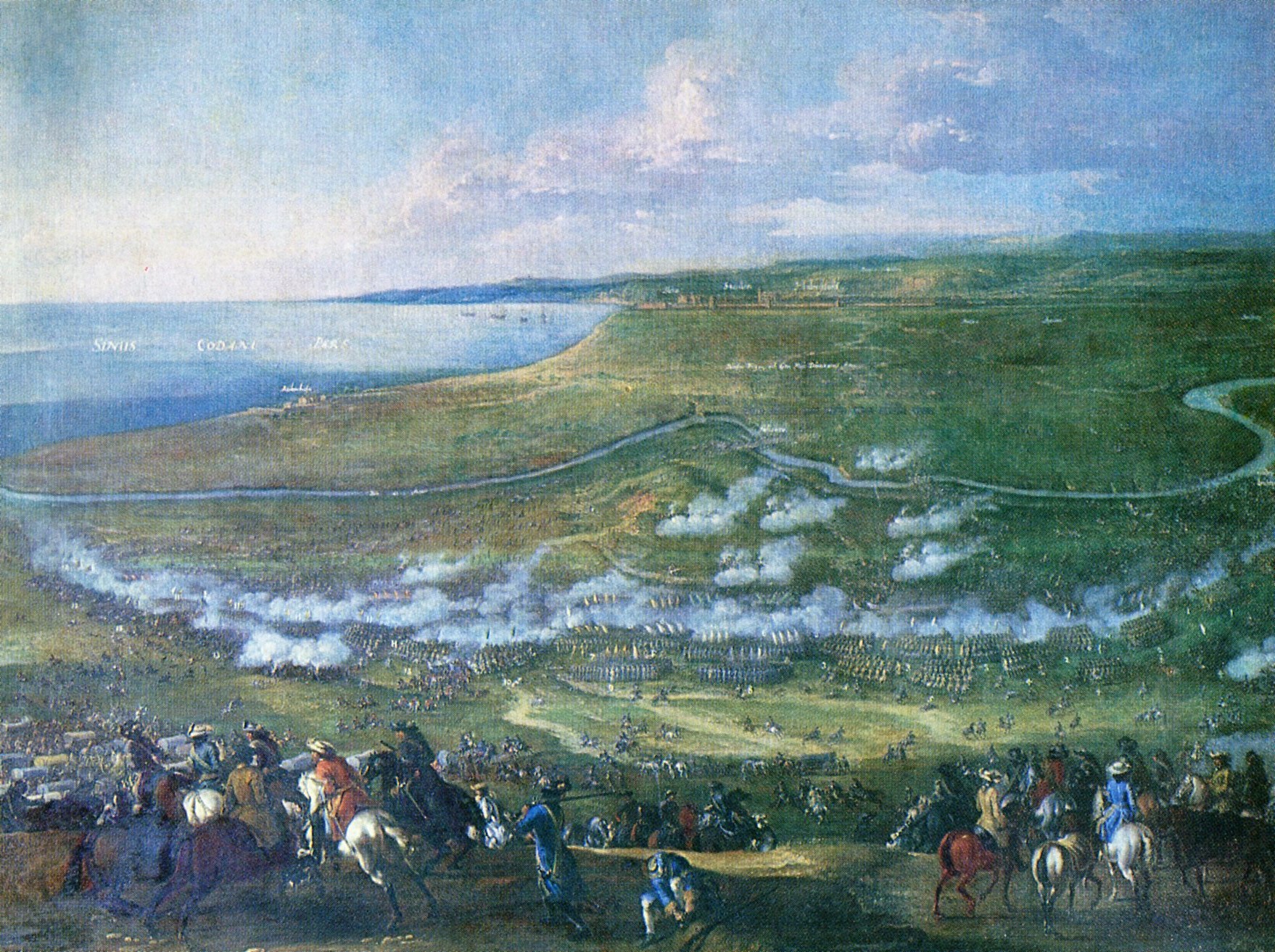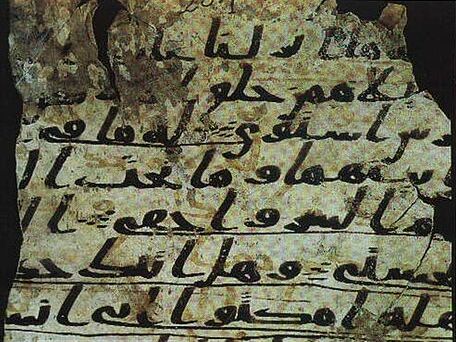|
Al-Mutawakkil Isma'il
Al-Mutawakkil Isma'il (c. 1610 – 15 August 1676) was an Imam of Yemen who ruled the country from 1644 until 1676. He was a son of Al-Mansur al-Qasim. His rule saw the biggest territorial expansion of the Zaidiyyah imamate in Greater Yemen. Early reign Al-Mutawakkil Isma'il was the son of the founder of the Qasimid imamate, al-Mansur al-Qasim. In 1644 his elder brother al-Mu'ayyad Muhammad died. With his death, fraternal strife broke out, as several brothers competed for the imamate. In the end, the other brothers submitted to Isma'il. In Zaidi sources, his reign is portrayed in exceedingly positive terms. Yemen was restored to prosperity as the farmers enjoyed excellent harvests. His rule was considered just and incorruptible. Nevertheless, in 1648 a dispute arose between the imam and the various ulema over taxation policy. As Ismail managed to uphold public order in the deeply localized and factionalized Yemeni society, merchants ventured to visit Yemen from other countries ... [...More Info...] [...Related Items...] OR: [Wikipedia] [Google] [Baidu] |
Zaydi State 1675
Zaydism (''h'') is a unique branch of Shia Islam that emerged in the eighth century following Zayd ibn Ali‘s Revolt of Zayd ibn Ali, unsuccessful rebellion against the Umayyad Caliphate. In contrast to other Shia Muslims of Twelver Shi'ism and Isma'ilism, Zaydis, also called Fivers, consider Zayd to be the fifth imam and successor to Ali ibn Husayn Zayn al-Abidin, instead of his half-brother Muhammad al-Baqir. Origin The Zaydi madhab, madhhab emerged in reverence of Zayd ibn Ali, Zayd's failed uprising against the Umayyad Caliph, Hisham ibn Abd al-Malik, Hisham (ruling 724–743 AD), which set a precedent for revolution against corrupt rulers. According to Hussein Badreddin al-Houthi, Zaydis find it difficult to "sit in their houses" and remain passive in an unjust world. Zaydis are the oldest branch of the Shia and are currently the second largest group after Twelver Shi’ism, Twelvers. Zaydis do not believe in the infallibility of Imāms and do not ascribe them with any su ... [...More Info...] [...Related Items...] OR: [Wikipedia] [Google] [Baidu] |
Ethiopia
Ethiopia, , om, Itiyoophiyaa, so, Itoobiya, ti, ኢትዮጵያ, Ítiyop'iya, aa, Itiyoppiya officially the Federal Democratic Republic of Ethiopia, is a landlocked country in the Horn of Africa. It shares borders with Eritrea to the north, Djibouti to the northeast, Somalia to the east and northeast, Kenya to the south, South Sudan to the west, and Sudan to the northwest. Ethiopia has a total area of . As of 2022, it is home to around 113.5 million inhabitants, making it the 13th-most populous country in the world and the 2nd-most populous in Africa after Nigeria. The national capital and largest city, Addis Ababa, lies several kilometres west of the East African Rift that splits the country into the African and Somali tectonic plates. Anatomically modern humans emerged from modern-day Ethiopia and set out to the Near East and elsewhere in the Middle Paleolithic period. Southwestern Ethiopia has been proposed as a possible homeland of the Afroasiatic langua ... [...More Info...] [...Related Items...] OR: [Wikipedia] [Google] [Baidu] |
1676 Deaths
Events January–March * January 29 – Feodor III becomes Tsar of Russia. * January 31 – Universidad de San Carlos de Guatemala, the oldest institution of higher education in Central America, is founded. * January – Six months into King Philip's War, Metacomet (King Philip), leader of the Algonquian tribe known as the Wampanoag, travels westward to the Mohawk nation, seeking an alliance with the Mohawks against the English colonists of New England; his efforts in creating such an alliance are a failure. * February 10 – After the Nipmuc tribe attacks Lancaster, Massachusetts, colonist Mary Rowlandson is taken captive, and lives with the Indians until May. * February 14 – Metacomet and his Wampanoags attack Northampton, Massachusetts; meanwhile, the Massachusetts Council debates whether a wall should be erected around Boston. * February 23 – While the Massachusetts Council debates how to handle the Christian Indians they had exile ... [...More Info...] [...Related Items...] OR: [Wikipedia] [Google] [Baidu] |
Zaydi Imams Of Yemen
Zaydism (''h'') is a unique branch of Shia Islam that emerged in the eighth century following Zayd ibn Ali‘s unsuccessful rebellion against the Umayyad Caliphate. In contrast to other Shia Muslims of Twelver Shi'ism and Isma'ilism, Zaydis, also called Fivers, consider Zayd to be the fifth imam and successor to Ali ibn Husayn Zayn al-Abidin, instead of his half-brother Muhammad al-Baqir. Origin The Zaydi madhhab emerged in reverence of Zayd's failed uprising against the Umayyad Caliph, Hisham (ruling 724–743 AD), which set a precedent for revolution against corrupt rulers. According to Hussein Badreddin al-Houthi, Zaydis find it difficult to "sit in their houses" and remain passive in an unjust world. Zaydis are the oldest branch of the Shia and are currently the second largest group after Twelvers. Zaydis do not believe in the infallibility of Imāms and do not ascribe them with any supernatural qualities, but promote their leadership. They also reject the notion of na ... [...More Info...] [...Related Items...] OR: [Wikipedia] [Google] [Baidu] |
Zaydi
Zaydism (''h'') is a unique branch of Shia Islam that emerged in the eighth century following Zayd ibn Ali‘s unsuccessful rebellion against the Umayyad Caliphate. In contrast to other Shia Muslims of Twelver Shi'ism and Isma'ilism, Zaydis, also called Fivers, consider Zayd to be the fifth imam and successor to Ali ibn Husayn Zayn al-Abidin, instead of his half-brother Muhammad al-Baqir. Origin The Zaydi madhhab emerged in reverence of Zayd's failed uprising against the Umayyad Caliph, Hisham (ruling 724–743 AD), which set a precedent for revolution against corrupt rulers. According to Hussein Badreddin al-Houthi, Zaydis find it difficult to "sit in their houses" and remain passive in an unjust world. Zaydis are the oldest branch of the Shia and are currently the second largest group after Twelvers. Zaydis do not believe in the infallibility of Imāms and do not ascribe them with any supernatural qualities, but promote their leadership. They also reject the notion of na ... [...More Info...] [...Related Items...] OR: [Wikipedia] [Google] [Baidu] |
Imams Of Yemen
The Imams of Yemen, later also titled the Kings of Yemen, were religiously consecrated leaders belonging to the Zaidiyyah branch of Shia Islam. They established a blend of religious and temporal-political rule in parts of Yemen from 897. Their imamate endured under varying circumstances until the end of the North Yemen Civil War in 1970, following the republican revolution in 1962. Zaidiyyah theology differed from Isma'ilism or Twelver Shi’ism by stressing the presence of an active and visible imam as leader. The imam was expected to be knowledgeable in religious scholarship, and to prove himself a worthy headman of the community, even in battle if this was necessary. A claimant of the imamate would proclaim a "call" (dawah), and there were not infrequently more than one claimant. History Establishment The imams based their legitimacy on descent from the Islamic prophet Muhammad, mostly via al-Qasim ar-Rassi (d. 860). After him, the medieval imams are sometimes known as the ... [...More Info...] [...Related Items...] OR: [Wikipedia] [Google] [Baidu] |
History Of Yemen
The history of Yemen describes the cultures, events, and peoples of what is one of the oldest centers of civilization in the Near East. Its relatively fertile land and adequate rainfall in a moister climate helped sustain a stable population, a feature recognized by the ancient Greek geographer Ptolemy, who described Yemen as ''Eudaimon Arabia'' (better known in its Latin translation, ''Arabia Felix'') meaning "''fortunate Arabia''" or "''Happy Arabia''". Yemenis had developed the South Arabian alphabet by the 12th to 8th centuries BC, which explains why most historians date all of the ancient Yemeni kingdoms to that era. Between the 12th century BC and the 6th century AD, it was dominated by six successive civilizations which rivaled each other, or were allied with each other and controlled the lucrative spice trade: Ma'in, Qataban, Hadhramaut, Awsan, Saba, and Himyar. Islam arrived in 630 AD, and Yemen became part of the wider Muslim realm. ... [...More Info...] [...Related Items...] OR: [Wikipedia] [Google] [Baidu] |
Al-Mahdi Ahmad
Al-Mahdi Ahmad (1633 – July 10, 1681) was an Imam of Yemen, who ruled in 1676–1681. He belonged to the Qasimid family that was descended from Muhammad. Struggle for the imamate Ahmad was a son of al-Hasan bin al-Qasim (d. 1639), a brother of the former imam al-Mutawakkil Isma'il. In the reign of his uncle, in 1658, he led forces that loosely incorporated Hadramaut in the Yemeni kingdom. When al-Mutawakkil Isma'il died, the imamate was claimed by Ahmad. He had, however, to fight his cousin and rival al-Qasim who controlled Shaharah, an almost impregnable fortress north of San'a. Ahmad collected forces which besieged Shaharah and forced al-Qasim to accept his claim. Reign At his accession, the imam was already a mature man in his upper forties. He upheld the Yemeni suzerainty in Hadramaut, and was reported to be a pious figure. His residence was al-Ghiras north-east of San'a. In 1679 the imam expelled the Jewish population from San'a and the surrounding regions, being fo ... [...More Info...] [...Related Items...] OR: [Wikipedia] [Google] [Baidu] |
Sana'a
Sanaa ( ar, صَنْعَاء, ' , Yemeni Arabic: ; Old South Arabian: 𐩮𐩬𐩲𐩥 ''Ṣnʿw''), also spelled Sana'a or Sana, is the capital and largest city in Yemen and the centre of Sanaa Governorate. The city is not part of the Governorate, but forms the separate administrative district of "ʾAmānat al-ʿĀṣima" (). Under the Yemeni constitution, Sanaa is the capital of the country, although the seat of the Yemeni government moved to Aden, the former capital of South Yemen in the aftermath of the Houthi occupation. Aden was declared as the temporary capital by President Abdrabbuh Mansur Hadi in March 2015. At an elevation of , Sanaa is one of the highest capital cities in the world and is next to the Sarawat Mountains of Jabal An-Nabi Shu'ayb and Jabal Tiyal, considered to be the highest mountains in the country and amongst the highest in the region. Sanaa has a population of approximately 3,937,500 (2012), making it Yemen's largest city. As of 2020, the greater ... [...More Info...] [...Related Items...] OR: [Wikipedia] [Google] [Baidu] |
Sabbatean
The Sabbateans (or Sabbatians) were a variety of Jewish followers, disciples, and believers in Sabbatai Zevi (1626–1676), a Sephardic Jewish rabbi and Kabbalist who was proclaimed to be the Jewish Messiah in 1666 by Nathan of Gaza. Vast numbers of Jews in the Jewish diaspora accepted his claims, even after he outwardly became an apostate due to his forced conversion to Islam in the same year. Sabbatai Zevi's followers, both during his proclaimed messiahship and after his forced conversion to Islam, are known as Sabbateans. Part of the Sabbateans lived on until well into 21st-century Turkey as descendants of the Dönmeh. Sabbatai Zevi Sabbatai Zevi was a Sephardic ordained rabbi from Smyrna (now İzmir, Turkey). A kabbalist of Romaniote origin, Zevi, who was active throughout the Ottoman Empire, claimed to be the long-awaited Jewish Messiah. He was the founder of the Sabbatean movement, whose followers subsequently were to be known as Dönmeh "converts" or crypto-J ... [...More Info...] [...Related Items...] OR: [Wikipedia] [Google] [Baidu] |
Sparta
Sparta ( Doric Greek: Σπάρτα, ''Spártā''; Attic Greek: Σπάρτη, ''Spártē'') was a prominent city-state in Laconia, in ancient Greece. In antiquity, the city-state was known as Lacedaemon (, ), while the name Sparta referred to its main settlement on the banks of the Eurotas River in Laconia, in south-eastern Peloponnese. Around 650 BC, it rose to become the dominant military land-power in ancient Greece. Given its military pre-eminence, Sparta was recognized as the leading force of the unified Greek military during the Greco-Persian Wars, in rivalry with the rising naval power of Athens. Sparta was the principal enemy of Athens during the Peloponnesian War (431–404 BC), from which it emerged victorious after the Battle of Aegospotami. The decisive Battle of Leuctra in 371 BC ended the Spartan hegemony, although the city-state maintained its political independence until its forced integration into the Achaean League in 192 BC. The city nevertheless ... [...More Info...] [...Related Items...] OR: [Wikipedia] [Google] [Baidu] |
Portugal
Portugal, officially the Portuguese Republic ( pt, República Portuguesa, links=yes ), is a country whose mainland is located on the Iberian Peninsula of Southwestern Europe, and whose territory also includes the Atlantic archipelagos of the Azores and Madeira. It features the westernmost point in continental Europe, and its Iberian portion is bordered to the west and south by the Atlantic Ocean and to the north and east by Spain, the sole country to have a land border with Portugal. Its two archipelagos form two autonomous regions with their own regional governments. Lisbon is the capital and largest city by population. Portugal is the oldest continuously existing nation state on the Iberian Peninsula and one of the oldest in Europe, its territory having been continuously settled, invaded and fought over since prehistoric times. It was inhabited by pre-Celtic and Celtic peoples who had contact with Phoenicians and Ancient Greek traders, it was ruled by the Ro ... [...More Info...] [...Related Items...] OR: [Wikipedia] [Google] [Baidu] |





